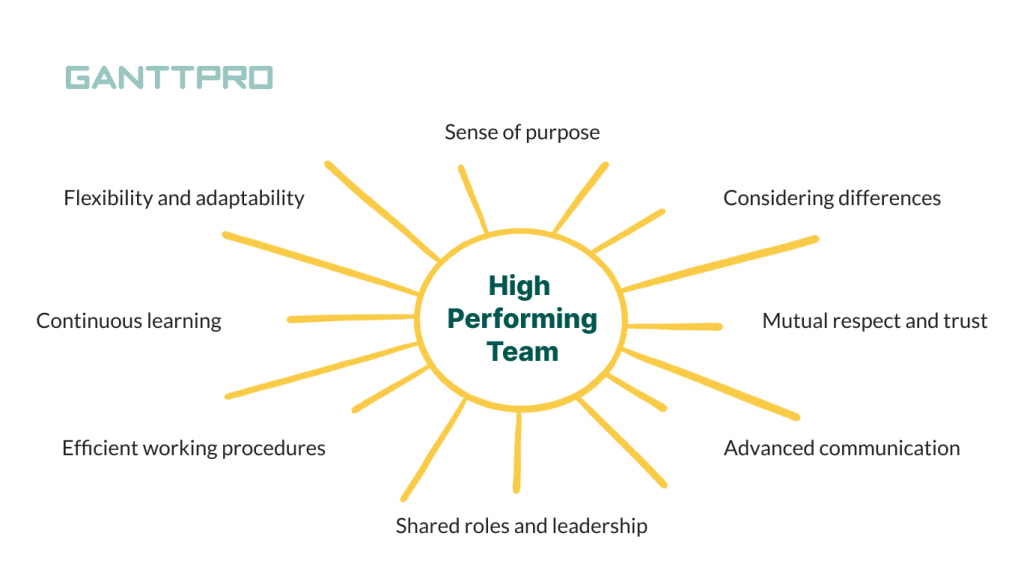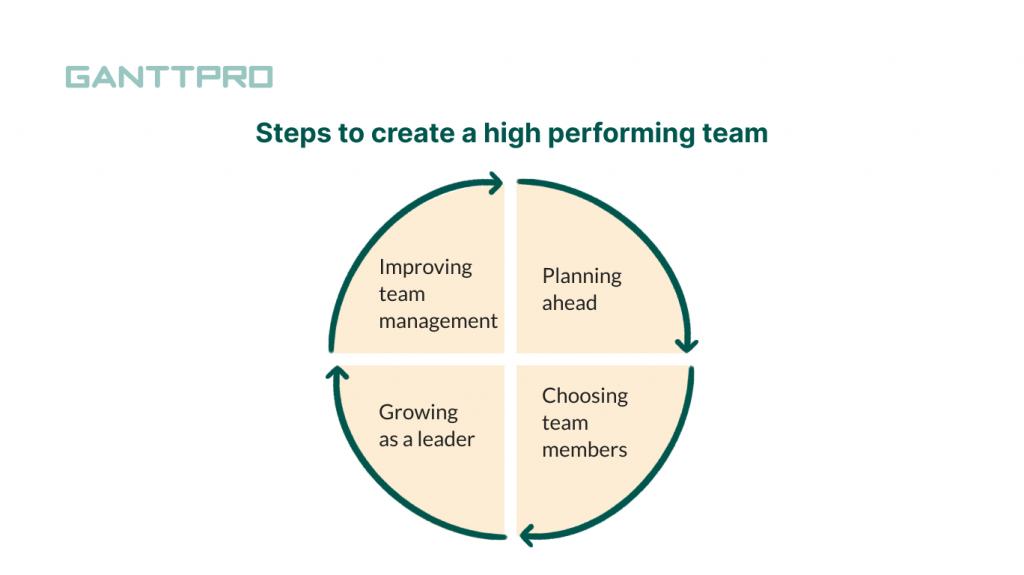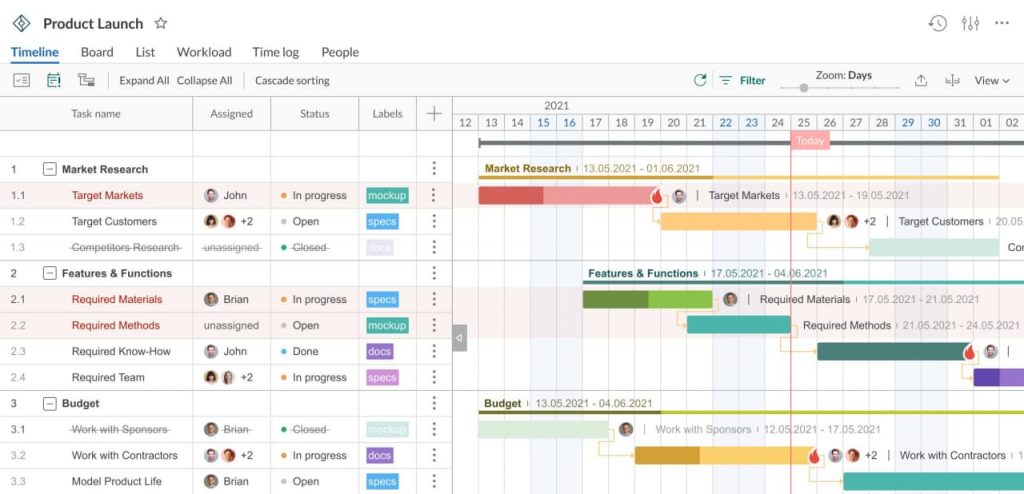How to Build a High Performing Team
August 10, 2021 / Estimated reading time: 13 minutes

Every business strives to meet specific standards. Managing high performing teams is one of them. 70% of companies admit that team performance matters; 30% of organizations have no strategy for creating a winning team.
Effective teams are made up of highly skilled and always focused and aligned individuals. If a company can attract and hire employees that may compose such a team, its business success is guaranteed. Here we describe the role and power of productive people in a group, the main traits and attributes of high-performing teams, and provide some non-trivial steps to build a team of your dream.
Contents:
- What is a high performing team?
- Characteristics of high performing teams.
- Consistent steps to create a high performing team.
What is a high performing team?
A high performing team is a group of people who can efficiently collaborate and deliver outstanding results. They understand all purposes and values of their organization.
All members in the high performing team model are mutually accountable for outcomes and committed to achieving the company’s specified goals.
People that usually comprise this team have different but complementary roles and responsibilities and work in sync like gears in a machine. These efficient teams typically outperform individuals because they have advanced experience and more skills. Additionally, they are more agile in problem-solving.
What is the key to high performance?
Team optimization is on the agenda of many companies around the world. According to the Oxford Review, more than 8100 peer-reviewed research papers directly look at high performing teams.
There is an interesting concept that describes the meaning of a high performing team with the help of an easy-to-remember acronym PERFORM, where:
- P = purpose and common values.
- E = empowerment in decision making.
- R = relationships and communication.
- F = flexibility.
- O = optimal productivity and efficiency.
- R = recognition and appreciation.
- M = morale.
Forming an efficient team is a challenge that brings together a variety of values, including upbringings, past work experience, individual goals, skills, and professional characteristics. Regardless of what types of teams you focus on, you will need a lot of effort to collect the best employees. They will communicate, cooperate and successfully perform in an atmosphere of mutual trust and respect.
Henry Ford once said:
Coming together is a beginning. Keeping together is progress. Working together is success.
These words of the great car business owner seem truthful. Henry Ford knew exactly how to build an effective team; otherwise, he would have failed. By the way, this is ideally confirmed in the movie “Ford vs. Ferrari” directed by James Mangold (2019).
Whether you want to form a winning sport team or manage an IT software project department, you’ll need a well-defined team-building strategy and a strong personality.
It looks easy enough, but where to start? Let’s begin with defining the essential traits of high-performing project teams. Of course, you may have your own opinion on this matter. Therefore, take a look and evaluate which of the following is true of high-performing teams.
Characteristics of high performing teams
As a rule, highly talented and motivated individuals with common goals make up productive groups. They know precisely how to help their companies in achieving excellence and growth. However, a primary problem with “dream teams” composed of high-performing people is that the overall team harmony can be tainted because every person has a different set of beliefs and principles.
There are several options for defining key characteristics of high performing team development, but we propose you dive into the most common set.

Which of the following is characteristic of members from high-performing teams? Or should some points be skipped or replaced with others? Let’s figure this out.
1. A sense of purpose
If your team members can clearly define the goals and mission of the company, they have a sense of purpose. They know how to set priorities and are driven with a strong focus on better results.
2. Flexability and adaptability
High performing teams include flexible and adaptable individuals. These employees can easily adjust to any given situation because variables don’t scare them. For example, a fast-paced working environment is not a problem.
3. Continious learning
The hunger for discoveries and newly acquired knowledge should continue the list of the apparent qualities of high performing teams. They strive to learn everything that may help them in improving their craft.
4. Efficient working procedures
As a rule, effective and productive team members are also resourceful. They are not satisfied with “good” but rather aim for the “best.” They find a unique way to achieve their goals and strive to encourage creativity.
5. Shared roles and leadership
Effective employees ask for ideas and suggestions from their colleagues. They value their peers’ insights and understand the critical role of each team member.
6. Advanced communication
Another essential characteristic of an effective team is constant communication. Individuals who are not afraid to express their thoughts and even strange ideas and thoughts are indeed professionals.
7. Mutual respect and trust
Respect and trust correlate with each other when it comes to a professional setting. If employees want to be a part of a successful team, they should learn how to respect and trust each other.
8. Considering differences
Successful people working altogether do not look at the differences or drawbacks of an individual. Instead, they try to create alternatives and other approaches that may be useful in various situations.
With the qualities of high performing teams listed above, modern groups and departments can do almost everything within their organizations. Being significant assets to the company, they guarantee an increase in sales and significantly boost employee morale.
Now you know the general characteristics of members from effective teams, so it’s time to determine the consistent steps of the strategy for building a high performing team of your dreams.
18 steps to build a high performing team
So what makes a high-performing team? What steps should an aspiring leader take to assemble and motivate employees? You will find the answers to these questions following the step-by-step tip set that we’ve composed in 4 blocks:
- Planning.
- Choosing team members.
- Growing as a leader.
- Improving team management.

Planning
1. Plan everything ahead
Striving to create and lead a high performing team, you should first answer the same questions that kids often ask their parents before a long trip: “Where are we going to?” and “How are we going to get there?” It means you should be able to communicate (and preferably visualize) the goal of your future team and how you are going to measure progress along the way.
Defining how a team’s success looks requires a clear plan with specific dates (where you’ll fix future interviews, meetings, team buildings, etc.) A simple to-do list, calendars, or a structured online Gantt сhart maker will help visualize this plan with all the tasks needed.
Look at how timelines in GanttPRO may help you succeed in this process:

Before following the next steps, try to determine priorities and how you will measure them. Perhaps, this is the most critical job for a leader as most of the work that everybody does will flow from those priorities.
Choosing team members
2. Interview candidates
Even a young project manager without experience should strive to know each person better, studying their background, work experience, skills, abilities, temperament, and character – everything that will help get a complete picture of who they are.
Often people’s skills can be different from what is on paper. That’s why face-to-face communication can be somewhat effective. During the interview, modulate a trial of a project or a routine closely related to what this person would be doing if they joined the team.
3. Invite best candidates
One of the most critical steps while creating an effective team is to choose people who can complement each other. It’s about unique chemistry and achieving a solid team spirit together. Successful candidates should be able to get along and build bonds.
Before choosing anyone, think about how you will use their talents to achieve your end goal – select mastery over personality. Influential team members should encourage each other to be productive and improve one another’s successes.
Choose people who can get the job done. They must persuade you that they can fulfill their responsibilities. Ask for references and talk to their past supervisors or coaches. Ensure you have a complete evaluation of a person’s abilities before making them a part of your team.
4. Foster diversity
Creating a diverse team opens more perspectives and provides unique ideas. It’s a good practice to hire people from varying backgrounds and ethnicities with different attitudes and philosophies. Diversity will help your team to solve problems from different viewpoints, contributing to driving success and innovations.
5. Define goals and values
Despite the diversity, employees should agree on the team’s goals and values. Everyone in a group should clearly understand their work, the outcomes, and how they should reach those goals. Advanced team collaboration software will help visualize this smoothly.

Project management software for high performing teams
Collaborate and get things done. All in one place.
Sign up for freeNote that these goals should be realistic and specific to avoid thinking that your team is working for a lost cause. A popular SMART goals concept looks rather beneficial to improve goals-setting in a short period.
6. Focus on roles
Hiring people to have similar bodies in a room can harm your company’s productivity. There is a concept of a revolving door when potential employees see their role as a temporary landing pad. They start to be less interested in learning and evolving, deciding that they will not fit anyway. Therefore, try to avoid this destructive approach.
Invest money and time in individuals who truly specialize in the roles your company needs.
7. Designate expectations
Team players should continually strive to accomplish the team’s plans and focus on a specific part of the project. Make sure their designated positions are clear and precise. Sometimes responsibilities can be merged or transferred to another person in the team.
Growing as a leader
8. Optimize your communication style
Team leaders should effectively communicate with each person in the group, encouraging transparency and partaking in active listening.
It’s crucial to listen to what people have to say attentively – they can shed light on issues from their perspective or point out something that you’ve missed.
9. Work with strengths and weaknesses
Realizing where you excel and where you need to make a push is an excellent skill for influential leaders.
Make efforts to work on the things that you are weak on every day and stimulate your strong sides. Ask for an honest evaluation of your leadership to understand the problems in your leadership style. It’s all about participative feedback.
10. Motivate team members
Any leader is the front person who drives a team towards success by giving them the encouragement that they need to do well.
How to motivate them? It can be everything from inspiration by your abilities to being rewarded for excellent work. Lead by example and demonstrate your care. Tastes and demands differ: some people appreciate positive reinforcement, while others prefer monetary incentives.
11. Expand trust and respect
When all team members immediately respect and appreciate a leader – it is about an ideal world. To reach this respect, you must work hard and gain their admiration thanks to your attitude, leadership style, experience, knowledge, and ability to settle conflicts. A great leader should always know how to fill in the gaps when the team is running behind.
Improving team management
12. Practice meetings
Some people sincerely think that too many meetings may cost unnecessary time and money. However, for some teams, weekly and daily meetings are an essential part of their workflows. For example, following Scrum requires practicing various ceremonies: Sprint Planning, Daily Stand-up, Sprint Demo, and Sprint Retrospective meetings.
Effective meetings require creating a clear plan of items that you will talk about beforehand and applying handy project scheduling software. Restrict the meeting length to be long enough to cover the essentials and not get bogged down in details or unnecessary stuff.
13. Resolve conflicts internally
One of the objectives of a good leader is to encourage the team to solve problems internally. Team members should communicate and settle challenges by themselves instead of escalating more and more issues.
When a disagreement between team members appears, it’s good to get to the bottom of the conflict before it gets personal.
14. Apply team-building activities
Team building management improves collaboration and communication between individuals, helping solidify relationships within the team.
There are various available team-building games and problem-solving activities in case you find your team in discomfiture and constant unproductive conflicts. These activities should be run weekly or monthly to be the most effective.
15. Dismiss chronically underperform team memebrs
Unfortunately, there always be employees who chronically underperform or, what’s even more – can be involved in severe misconduct (assault, harassment, theft, etc.). An effective team does not need such bad players, so it is better to dismiss them immediately.
However, in some cases, it’s better to talk to them first and allow them to improve before dismissing them.
16. Add coaching
Underperforming team members may need your special attention and coaching. The ability to identify issues in someone’s working habits and find solutions to remedy them is a clear sign of a good leader. Try to explain the areas you think the person is underperforming in and think of strategies to improve their performance. Focus on these areas, not the character or personality.
17. Master emotional intelligence
Emotional intelligence (EI) is a powerful driver when it comes to improving your teamwork performance. It is about harmonizing thoughts and emotions. When you care about it, EI can help to transform understanding of the vital team processes.
EI requires employees to be wise, self-aware, and regulate their emotional responses in different scenarios. A team with enough knowledge given by EI will communicate more effectively and foster an attitude of engagement and loyalty.
18. Encourage trust and transparency
If team leaders are not trusted, they can not get team members to embrace stretch goals or believe their communications. The lack of trust may slow down everything. To develop it, you should pay special attention to the core pillars that build trust: relationships, knowledge (or expertise), and consistency. Remember that when you say you will do something and you do it, your colleagues trust you.
Final thoughts
Building high performing teams is a crucial responsibility for any manager and team leader. You will not achieve great results quickly, but it is worth undertaking this ongoing organic process that you will need to maintain and guide.
It is true that high-performing teams go through repeated cycles of disassociation and association. But as this process unfolds, your colleagues will trust you more and support one another, sharing their knowledge and unique skills.
Now you know what makes a high performing team. Don’t forget that there is little that individuals cannot accomplish when they work well in a group together. Look at the bigger picture to increase your chances of developing and maintaining the best work team ever!
